#taurine deficiency
Note
⋆ gently reminding them to eat /post raid ;w;
It was hardly uncommon for Tim to go extended periods without eating, sometimes having even forgotten all together. Usually focused on something else or despite knowing they should found himself unable to actually will himself into doing it. As long as he regularly ate something with animal proteins he didn't need much.
The raid only making things worse, laying low and hiding hadn't left him much opportunity to eat, after reuniting with Luna his appetite was still lacking.
Traveling north hadn't done much favours, the chill in the air only making him want to sleep more then eat as his metabolism significantly slowed.
Recently his anxiety felt worse and while no medical expert from what he had picked up from his father had begun to wonder about the occasional muscle tremors that had started. Still he kept it quietly to himself, what good would it do to cause more worry.
Curled up next to the window he was right in the midst of dozing off again when he felt a light nudge, rubbing the sleep from his eye and yawning largely. Green eyes looked up to see Luna carrying a tray of food acquired from the dining car,
"M'not..." His voice trailed, the look in her eye telling him this time she wouldn't be taking no for an answer this time.
"Only if you eat too,"
He finally agree with a heavy sigh
@lunaferrous
#lunaferrous#/tim pls eat#heaven to hell; post raid#depression tw#/he's heading toward a taurine deficiency#/his body doesn't do well in making its own like most people and animals can do- rather like a cat in that regard#the stone doing what it can to keep him going sure and in part how he can manage so long on so little but yeh#/ emotionally and physically and mentally exhausted lad#so has def not been eating well at all since the raid (when he does eat asf)#/they're just going through it
1 note
·
View note
Text
New research has been published this month on diet and dilated cardiomyopathy.
The paper can be accessed here: https://onlinelibrary.wiley.com/doi/abs/10.1111/jvim.16606
Key takeaway: When compared between diet groups, healthy adult dogs eating diets containing pulse legumes (peas, lentils, chickpeas, beans) as main ingredients have lower cardiac function and higher ventricular volume than dogs eating grain-inclusive diets without potatoes or pulses in the first 10 ingredients.
Study summary:
In this study, researchers sought healthy, owned adult dogs that had been consistently eating the same diet for at least 1 year duration and receiving 90% or more of their daily calories from a single commercial kibble. Diets were divided into "traditional" (grain-containing, no pulse legumes or potatoes in the first 10 ingredients) and "non-traditional" (pulse ingredients as main ingredients). In order to address potential confounding variables, researchers excluded dogs with congenital heart disease, heart murmur, or arrhythmia, as well as several breeds based on their potential predisposition to DCM or taurine-deficiency. In total, 23 dogs matched for age and breed were enrolled into each study group.
Dogs accepted into the study received an echocardiogram. The screened dogs had cardiac measurements falling within accepted reference ranges for normal. However, on average, dogs in the non-traditional diet group had reduced systolic function (the ability of the heart to pump out blood to arteries) and larger ventricular volume (the amount of blood filled into the chamber before being pumped out-- excessively high volumes, or volume overload, is a component of heart disease). Researchers note that further study would be needed to determine if increases in ventricular volume precede increases in ventricular measurements.
Researchers conclude: "Despite these limitations, results from this study showed that dogs eating nontraditional diets had several echocardiographic variables suggestive of larger left ventricular size and lower myocardial systolic performance as compared to dogs eating traditional diets, although echocardiographic variables for both groups were largely within extant reference intervals.”
257 notes
·
View notes
Note
the remaining Carnohams are all pretty cat like, are they also obligate carnivores?

Descendants of the meowse, a small carnoham that was the sole survivor of the Glaciocene of its entire clade, all the extant carnohams in the Temperocene are obligately carnivorous: requiring taurine and other amino acids in their diet that would lead to illness and even blindness if deficient, and entirely unable to consume plant matter of any sort, suffering indigestion and diarrhea if they do-- something certain carnoham species do on purpose to purge their stomachs if they feel unwell.
Yet one distinctive species, a lone genus in its own separate subfamily, is a notable exception to this rule: the bobtailed cliffheath (Vulpailurumys alpinus), native to the highlands and mountainous forests of northeast Arcuterra. This species stands out due to its more varied diet: indeed, it is an omnivore, rather than a pure carnivore, in a stark departure to the rest of its carnoham kin.
Cliffheaths are expert climbers, and can scale steep mountainsides and clamber up trees in search for food: typically rattiles, squizzels, ratbats and other small prey. Yet they will also feed on insects, especially termites and ants which they dig out of their nest with distinctive hooked claws that are only semi-retractable, and their plentiful larvae. But most remarkably, perhaps, is the cliffheath's occasional consumption of plants and fruit, from the abundant flowering cloverferns up in the plateaus of the mountains. These form less than 10-15% of its diet, with the remainder still being meat, yet for such specialized carnivores to regularly include any quantity of plant matter in its diet is remarkable in itself.
Cliffheaths live and hunt together in cooperative mated pairs, typically staying together for life unless with the death of one of the partners, in which case the survivor of the pair will court again. They use their climbing and digging abilities to make dens in steep mountainsides or the bases of tree roots where they can safely rear their young, typically two or three in a litter, safe from predators--larger carnohams, zingos, and pterodents-- until they are developed enough to leave the den and accompany their parents when foraging, acquiring vital survival skills as they do to prepare them for an independent life upon adulthood.
-----------
57 notes
·
View notes
Text
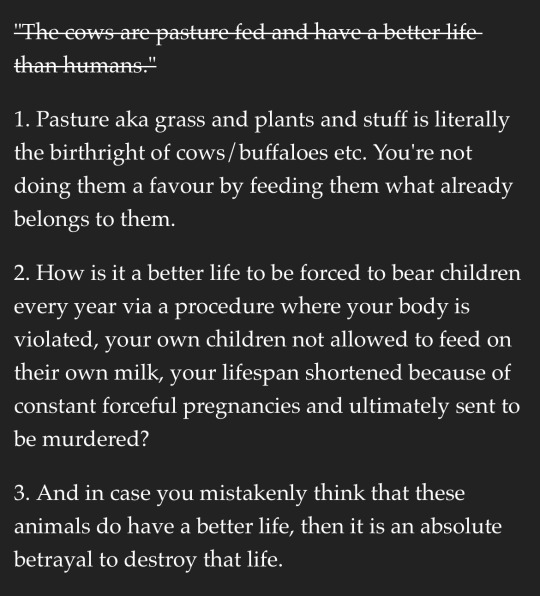

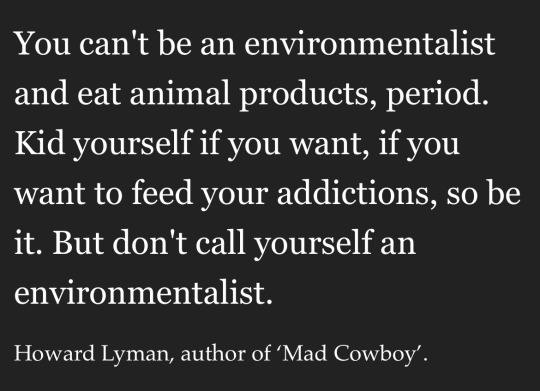

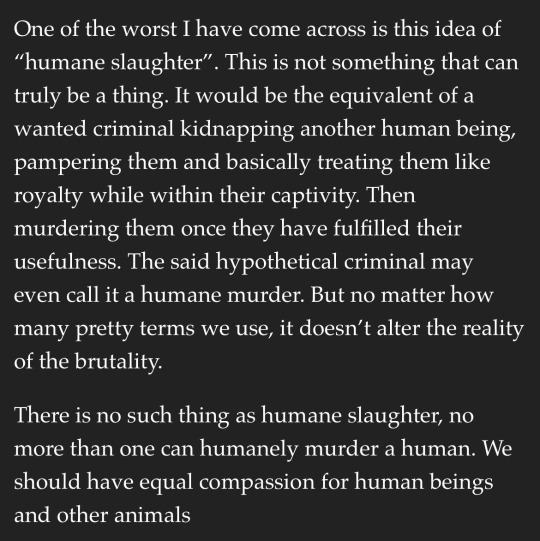
I went on a little walk through the animal rights tag after accidentally clicking it instead of animal welfare. A lot of Normal Guys in there for sure.
Beginning to think a taurine deficiency may be causing the part of their brain which recognizes that humans are omnivores and do in fact eat meat for reasons other than “addiction” to the “pleasure of eating something” to deteriorate.
If you find yourself saying “the birthright of cows” and comparing cattle ranches to murder victims or human slavery, please sit down.
Also please go to an actual dairy farm and educate yourselves on what actually goes on there instead of playing a game of telephone with people who simp for peta and just guessing from there.
#Good lord some of these people are insane#the ‘fleeting pleasure of eating something’ one just sounds Catholic#DENY THINE BODY OF ALL WORDLY PLEASURES LEST YE BE BANNED FROM THE KINGDOM OF GOD#THOU MUST SUFFER A LIFE OF BLANDNESS AND EAT ONLY KELLOGGE#the racism mixed in some of these sure is interesting
92 notes
·
View notes
Text
@aristonsilvester
location: Base Camp
notes: idk few nights in, appreciate the Usher quote and love me ty
The thing about cats was they could do more than see in the dark, they could lengthen their spines for short bursts of speed up to thirty miles an hour. They could narrow their shoulders and chests to squeeze into tiny spaces. They could jump nine times their height from a standing position and land on their feet almost every time they fell. Cats at their prey because their bodies didn't produce enough taurine, an essential amino acid: they were predators because they were deficient.
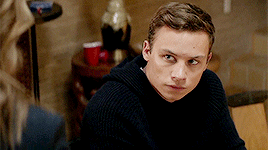
A knife drove into the armrest of Atlas' chair, chips carved into the wood grain one after the other. Eoin was taken. Optimism wasn't something that the druid fucked with so he was probably dead or worse, Death didn't seem to be taking people no matter how much they begged. In the field Atlas had seen a symbiote twist a man's spine so violently without severing any nerves that the guy would have been better off. Esme went into the mud on the first day, Evy was gone too, taken alongside Eoin. Octavian... Atlas could still feel him in the way that he always felt him, but he was further away now. Distant, like instead of a scream he'd been reduced to a whisper. The addition of phoenix fire to his daughter's arsenal was telling.
With every removal of the knife from the grain, Atlas turned it over in his hand, slid across the back of his thumb before he gripped it again and pushed it hard into the armrest once more. His deadpan stare looked off into the dark of the woods, he could hear them out there, they could all hear them. Inside Atlas' mind there was the instinct of the avis ready to take flight, it conflicted with the urge of the viper ready to striker, and last of all was the felidae desperately trying to survive. His last words to Eoin had been- they hadn't been his shiniest moment.
"Any words of advice from an almost-archdruid?"
6 notes
·
View notes
Text
Vet Med in Warrior Cats: Reproduction and Theriogenology
Disclaimer
Additional disclaimer for this one: I fully understand why a lot of these issues were not addressed in the series since it is written for children, but I still think the topic is interesting and that some concepts, especially those involving kitting, could have been more accurate.
Cats are seasonally polyestrous long day breeders, meaning that the females only cycle reproductively in the spring and experience multiple heat cycles every breeding cycle. Estrous cycles occur when the females are exposed to over 14 hours of light every day, so depending on the climate that they are in, cats are only able to become pregnant in the spring and fall. A queen’s gestation period (the time that they spend pregnant) is 2 months, so queens can have their kits from about late spring to early fall. The location of warriors is never confirmed, but it is presumed to be in England or the UK since that is where the authors are based, and since it snows every winter. With a colder, darker climate, this breeding season is even shorter. Queens in warriors are shown to have their kits at any time of year, even in the dead of winter. It is possible for some females, especially short haired breeds, to be able to cycle year-round, but not common. Narratively it makes sense to spread the litters out, but realistically the clans would have most of their kittens in the summer and fall.
Cats are also induced ovulators, which means that ovulation is triggered by and occurs about 24-48 hours after mating. Females need to be in estrus to allow mating, but the induced ovulation makes it very likely that pregnancy will result from mating. Females may also mate with multiple males over the span of a few days, meaning that one litter can have multiple fathers. This is not something we would see in warriors since there is an unspoken societal standard of monogamy.
Pregnant cats require almost double their normal nutrient intake in the second half of gestation, and even more while nursing. Taurine deficiency can cause pregnancy loss, as well as malnutrition in general. It would not be uncommon for a queen to lose her pregnancy if prey is scarce in her clan. There are several infectious causes of pregnancy loss, including feline herpes, FIV, FIP, feline panleukemia, toxoplasma gondii, and other bacterial infections of the reproductive tract. Many of these diseases, especially feline herpesvirus, are extremely common in feral cat populations. Early, undetected embryonic loss from these diseases could be a reason for why female cats in warriors are not pregnant as often as real life feral cats, but that is unlikely. Cats in warriors seem to be able to plan when they become pregnant (except when it's a secret forbidden romance of course), and I have no explanation for why that could be. Unless the medicine cats discovered an herb that can act as contraception (progestagens, dexamethasone (a gluccocorticoid) and dopamine agonists can all be used in companion animals as temporary contraception, but they all have moderate systemic side effects).
At the start of parturition (birthing), queens become restless, pace, and nest. Once uterine contractions begin, the “water breaks” and a kitten should be delivered every 3 to 5 minutes. This entire process can take anywhere from 4 to 42 hours, with the average being about 16 hours. It’s unclear how much time the birthing process takes in warrior cats, but it usually seems to be much faster than this. In Bluestar’s Prophecy, when Leopardfoot has been kitting for “most of the afternoon” and then into the night, this is implied to be an abnormally long amount of time.
Dystocia (complications with pregnancy) are pretty rare in cats. The most common cause is primary uterine inertia, which is when the queen is unable to begin uterine contractions. This would be treated with oxytocin in a veterinary clinic to induce contractions. Borage is stated to be used to help with milk let down and may work to stimulate oxytocin since oxytocin is also used to stimulate milk letdown. The other common causes of dystocia are uterine torsion and oversized fetuses, both of which would require a C-section to correct.
When Sorreltail is kitting in The Forgotten Warrior, she is described to be in pain and having trouble passing the kits. Jayfeather gives her chervil root to help, so it is implied to be either something to give Sorreltail strength or to help with uterine contractions. Several sources said that chervil can be useful for cough, eczema, and even abscesses, but there was no indication that it could be useful during childbirth.
Leopardfoot is also described to have a long, painful kitting in Bluestar’s Prophecy. Featherwhisker gives her raspberry leaves. Raspberry leaves have been shown to benefit with strengthening uterine tone and facilitating contractions, so this herb would be more useful than chervil root. Two of Leopardfoot’s kits die young because she kitted two weeks too early. This is called “fading” and occurs because the kits were not able to thermoregulate or breathe properly. Premature kits are less likely to be developed properly, and may be lacking in reflexes such as suckling that would have helped them to acquire sufficient nutrients and immune-boosting milk (colostrum).
In Crookedstar’s Promise, Brightsky delivered 3 stillborn kits followed by one surviving kit, and then died. Brightsky had been sick not long before her kitting and was described to still be weak from her illness. Brightsky likely was sick with a virus that causes late term abortion, like herpes, FIV, or panleukemia. While it is possible for a cat to abort some fetuses and still deliver other fetuses to term, it’s not common, especially this late into the pregnancy. I honestly was not able to find the most concrete information on this, but it is feasible for Leapordkit to have survived. As for Brightsky, she likely died because the three stillborn fetuses mummified inside of her, causing her to develop an infection. If this were true, she would have had dark or purulent vaginal discharge and had abdominal pain even before her kitting.
Silverstream also died from dystocia after delivering her kits in Forest of Secrets. She is described to have powerful spasms that slowly got weaker, which sounds like secondary uterine inertia (when the queen is too exhausted to continue contractions). Since she only had two small kits and fetal malpositioning is rare in cats, there might have been some sort of obstruction to the birth canal. In later books, Silverstream was described to have been “blood soaked”. Possible causes of hemorrhage during birthing could be uterine vessel tearing, uterine rupture, or uterine torsion. Uterine torsion would cause an obstruction to the birth canal and would require emergency surgery. The likelihood of Featherkit and Stormkit surviving would have been very low without the ability to intervene and there are no reported cases of a uterine torsion resolving without surgery. It is most likely that Silverstream experienced uterine rupture due to the stress of contractions.
There are several other common reproductive issues that do not appear in warriors. Mammary hyperplasia is the spontaneous overgrowth of mammary tissue in intact female (and sometimes male) cats. This condition usually spontaneously regresses, but it can be confused with mammary neoplasia. Mastitis is the bacterial infection of mammary glands after parturition. This condition is not only painful and dangerous for the queen, but can cause the kits to fail to thrive. This would be treated with antibiotics, warm compresses, and milk replacer for the kittens in a veterinary clinic. Cystic endometrial hyperplasia is a degenerative condition mediated by a hormone called progesterone. Too much progesterone causes the endometrial glands to proliferate and over-secrete hormones, making the uterus an ideal environment for bacteria and leading to pyometra (bacterial infection of the uterus). Depending on if the cervix is open or closed, the queen will either have purulent vaginal discharge or the pus will build up in the uterus. While a closed cervix is more dangerous, both will cause the cat to feel extremely sick, vomit, run a fever, and experience renal dysfunction. A pyometra can quickly develop into a systemic condition, so emergency ovariohysterectomy is required to save the cat's life.
Sources:
BSVA Manual of Canine and Feline Reproduction and Neonatology. Gary England and A. von Heimendahl, 2nd Ed, 2011
L. Ari Jutkowitz, Reproductive emergencies, Veterinary Clinics of North America: Small Animal Practice, Volume 35, Issue 2, 2005
https://journals.sagepub.com/doi/pdf/10.1177/2055116917726228
https://www.merckvetmanual.com/reproductive-system/reproductive-diseases-of-the-female-small-animal/dystocia-in-small-animals
https://www.rxlist.com/chervil/supplements.htm
https://healthyfocus.org/health-benefits-of-chervil/
https://www.bbcgoodfood.com/howto/guide/top-9-health-benefits-of-raspberry-leaf-tea
#I have a therio test tomorrow and spent almost 4 hours on this because priorities right?#vet med#vet med in warrior cats#warrior cats#warriors
5 notes
·
View notes
Note
This is weird but I have my own headcanon for the vegan Muse. I headcanon that they stumbled across Project Chimera and was so traumatized by HMF's actions that they stopped eating animal products altogether due to the belief that all farms are just like the one they came from.
They also have a taurine deficiency due to this, as obligate carnivores such as Muses need this amino acid to function (this is why you should not make your dog or cat go vegan)
DAMN that sounds good
love your headcanon bro(or sis.. sorry i just love calling everyone "bro")
3 notes
·
View notes
Text
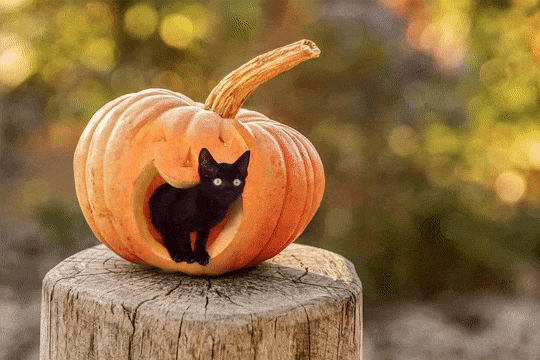






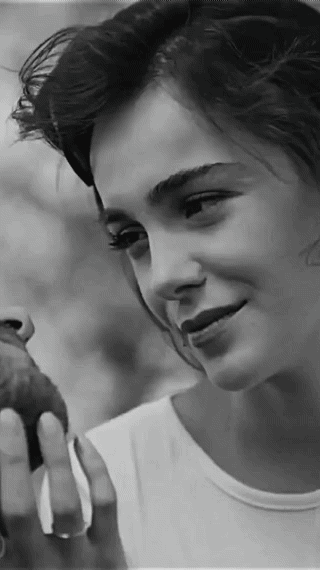


Good morning my precious beloved Bears .. Angels .. I hope you .. had a good night's rest.
So many thoughts & feelings this morning I feel like that! But trying to organize enough to write you . . . . . It's a bit jumbled right now.. so please be patient with me. Chewing my lips.
I have been having nightmares & weird dreams. Well.. most of my life. That's taurine & gaba deficiency. But. I believe when we are ok. .. They are full of us & love. Because they are! Love those nights! I wake up with a smile & feel so surrounded by your love... the world could implode & I wouldn't care.
But when I feel insecure & unsure & well totally outta the loop.. I get anxious. It's not just a midnight phenomena either. Struggling to understand where & how I fit into your life... leaves me feeling unworthy & unsure of myself.
May be because of the weather changes, that I'm more susceptible to the adversary tricks attacking me. I mean the adversary knows what bothers me.. my chubby tummy.. needing reconstructive surgery.. my suffering health.. but mostly.. it's my feelings of inadequacy because I've been taught to feel...less. that I'm not smart enough, pretty enough, but too much in everything else. That I wasn't meant for a true love. but rather to settle foe someone to support me. I should just get a little job to occupy my time & not expect babies nor to be wanted by my spouse. It really does a number on my soul. My mom says those things to me. Hard to build a wall against my mother. But seems the only way I can heal is to face & accept that... I have a difficult parent. And I will never receive a mother's true love from her. Sometimes.. it manifests in such horrible ways..
Makes it so difficult to see what you .. see.. in me. I believe you . . . . . Just hard to get it into my head. For it to restore & encourage me. The way God means it to. The phrase "love yourself first" comes to mind. And I just don't understand how. I have confidence in myself, my abilities, that I'm capable. But.. that. I gotta see what I can read & definitely need to pray on this.
[Getting lag so gotta close. Tumblr & network issues probably.]
I mean I also have been wanting to write to you .. a love scene that's been in my head well.. years.. kitchen sink. Slow blushing shyly grin. It hit me like well.. you... my hurricane. My Bears Angels .. That one got me yesterday ~11am. You . . . . . Hhhmmm.....
Ok. Before I lag myself to death. And start going there..
I love you .
Even when.. I'm confused.. outta the loop.. scared.. thinking bad thoughts about how could what I'm thinking possibly be. But I know it is. In my soul. I know it. In my soul, my instincts, intuition.. you ..... you want & crave me .. just like I'm squirming for you ... right now. You make me shiver... always have. But do I...you...???
Chewing my lips.
I won't give up. I believe. I work. I await.
~True love never dies & true love always waits.~
Your confused, struggling with it all cause I'm outta the dang loop! But..listening. sigh.
Your complex quirky warrior queen daughter.
~Tijgeress kat Phoenix. ✝️🌺🐾🐯
🤓⚓🙏🙇♀️⛓🧰🥮🍯🍼
⌚💡⚡🌠🔱⚜🗝💝🐻🦌🧩♠️♾🧭🕯
Fr.12.2.2022 10.44am est. Damn lag.
2 notes
·
View notes
Text
Nourishing Hearts: Exploring the Relationship Between Dehydrated Dog Food and Canine Heart Health
Introduction:
In recent years, the pet food industry has witnessed a surge in the popularity of dehydrated dog food. Pet owners are increasingly drawn to this type of food for its convenience, nutritional benefits, and purported positive effects on their furry companions' health. Among the many touted benefits, one area of interest is the potential impact of dehydrated dog food on canine heart health. In this blog, we delve into the connection between dehydrated dog food and the well-being of our beloved four-legged friends' hearts, while also examining the dynamics of the growing Dehydrated Dog Food Market.
Understanding Dehydrated Dog Food:
Dehydrated dog food is a type of pet food that undergoes a dehydration process to remove moisture while retaining the nutritional integrity of the ingredients. Unlike traditional kibble, which is processed at high temperatures, dehydrated dog food is typically prepared using gentle, low-heat techniques. This minimal processing is believed to preserve the natural nutrients found in the ingredients, making it an appealing option for pet owners seeking wholesome nutrition for their dogs.
The Rise of the Dehydrated Dog Food Market:
The demand for dehydrated dog food has been steadily increasing, driven by factors such as pet owners' growing awareness of the importance of nutrition in their pets' diets and a desire for convenience without compromising on quality. Manufacturers in the pet food industry have responded to this demand by offering an array of dehydrated dog food options, ranging from grain-free formulas to recipes tailored for specific dietary needs.
Canine Heart Health: A Critical Concern:
Heart health is a crucial aspect of overall well-being for dogs, just as it is for humans. Conditions such as congestive heart failure, dilated cardiomyopathy, and valvular heart disease can significantly impact a dog's quality of life and lifespan. While genetics and breed predispositions play a role in determining a dog's susceptibility to heart issues, diet and lifestyle factors also exert significant influence.
The Role of Nutrition in Canine Heart Health:
Nutrition plays a pivotal role in maintaining cardiovascular health in dogs. A balanced diet that provides essential nutrients, such as omega-3 fatty acids, antioxidants, and taurine, can support heart function and reduce the risk of cardiac diseases. Dehydrated dog food, with its emphasis on preserving natural ingredients and nutrients, holds promise as a dietary option that may contribute to canine heart health.
Key Nutrients in Dehydrated Dog Food and Their Impact on Heart Health:
Omega-3 Fatty Acids: Found in ingredients like fish and flaxseed, omega-3 fatty acids have anti-inflammatory properties that can help reduce the risk of heart disease and support cardiovascular function in dogs.
Antioxidants: Ingredients such as fruits and vegetables in dehydrated dog food are rich in antioxidants, which help combat oxidative stress and promote heart health.
Taurine: An amino acid essential for cardiac function, taurine deficiency has been linked to certain types of heart disease in dogs. Dehydrated dog food formulations often include ingredients that are naturally rich in taurine, such as meat and organ meats.
Conclusion:
As pet owners increasingly prioritize their dogs' health and well-being, the demand for high-quality, nutritionally balanced pet food continues to grow. Dehydrated dog food, with its focus on preserving natural ingredients and nutrients, emerges as a promising option for supporting canine heart health. While further research is needed to fully understand the impact of dehydrated dog food on heart health, its popularity reflects a broader trend toward holistic pet care. By choosing nutritious foods and providing regular veterinary care, pet owners can take proactive steps to promote the longevity and vitality of their canine companions.
In the dynamic landscape of the Dehydrated Dog Food Market, the conversation around canine heart health serves as a reminder of the interconnectedness between diet, lifestyle, and overall wellness for our beloved pets.
0 notes
Text
IV Therapy for Stress Relief and Mental Well-being: A Holistic Approach
Introduction: In today's fast-paced world, stress has become an unavoidable part of daily life for many people. Chronic stress can take a toll on mental well-being, leading to anxiety, depression, insomnia, and other health issues. While traditional stress management techniques such as meditation and exercise are beneficial, IV therapy offers a holistic approach to stress relief and mental well-being. At InfusaLounge Wellness Spa, we offer customized IV therapy treatments designed to promote relaxation, reduce stress, and support mental wellness.
Heading 1: Understanding the Impact of Stress on Mental Well-being Stress is the body's natural response to perceived threats or challenges, triggering the release of hormones such as cortisol and adrenaline. While acute stress can be helpful in certain situations, chronic stress can have detrimental effects on mental and physical health. Prolonged exposure to stress can disrupt sleep patterns, impair cognitive function, weaken the immune system, and contribute to mood disorders such as anxiety and depression.
Heading 2: The Role of IV Therapy in Stress Relief IV therapy offers a unique approach to stress relief by delivering a potent blend of nutrients directly into the bloodstream, promoting relaxation, and supporting mental well-being. IV infusions Medical spa bypass the digestive system, ensuring rapid absorption and maximum bioavailability of nutrients, which is particularly beneficial for individuals experiencing stress-related digestive issues or nutrient deficiencies.

Heading 3: Calming Nutrients for Relaxation IV therapy infusions at InfusaLounge contain a variety of nutrients known for their calming and mood-enhancing properties, including magnesium, vitamin B6, and amino acids such as taurine and glycine. These nutrients help promote relaxation, reduce anxiety, and support mental well-being by modulating neurotransmitter activity and promoting the production of calming brain chemicals such as GABA.
Heading 4: Replenishing Essential Nutrients Chronic stress can deplete the body's stores of essential nutrients, leading to deficiencies that further exacerbate stress and mental health issues. IV therapy infusions deliver a balanced blend of vitamins, minerals, and antioxidants directly into the bloodstream, replenishing nutrient levels and supporting overall health and well-being. By ensuring adequate nutrient intake, IV therapy helps combat the negative effects of stress on the body and mind.
Heading 5: Hydration and Detoxification for Stress Relief Proper hydration is essential for stress relief and mental well-being, as dehydration can exacerbate stress symptoms and impair cognitive function. IV therapy infusions at InfusaLounge provide rapid hydration and electrolyte replenishment, helping to restore fluid balance and support optimal brain function. Additionally, IV therapy promotes detoxification by flushing out toxins and waste products from the body, reducing oxidative stress and inflammation associated with chronic stress.
Heading 6: Personalized Treatment Plans for Stress Relief At InfusaLounge Wellness Spa, IV therapy treatments are tailored to meet the unique needs and preferences of each client. Our healthcare providers work closely with clients to assess their stress levels, identify underlying imbalances, and create personalized infusion formulas that promote relaxation, reduce stress, and support mental well-being. Whether you're dealing with work-related stress, relationship issues, or general anxiety, IV therapy at InfusaLounge offers a safe, effective, and holistic approach to stress relief.
Heading 7: Conclusion In conclusion, IV therapy infusions at InfusaLounge Wellness Spa offer a holistic approach to stress relief and mental well-being. By delivering calming nutrients, replenishing essential nutrients, promoting hydration, and supporting detoxification, IV therapy helps reduce stress, promote relaxation, and support overall mental wellness. Whether you're looking to manage chronic stress, alleviate anxiety, or simply unwind and relax, IV therapy at InfusaLounge can help you achieve a greater sense of calm, balance, and well-being
0 notes
Text
Can Cats eat Vienna Sausages?
It's generally not advisable to give Vienna sausages to your cat. While they may seem like a tasty treat, they can actually be quite harmful to your feline friend. Here's why:
High in sodium: Vienna sausages are packed with sodium, which can be dangerous for cats. Too much salt can lead to dehydration, high blood pressure, and kidney problems.
High in fat: Vienna sausages are also high in fat, which can cause digestive upset, pancreatitis, and obesity in cats.
Spices and preservatives: Some Vienna sausages contain spices and preservatives that can be toxic to cats, such as garlic, onion, and nitrates.
Nutritional deficiencies: Vienna sausages lack the essential nutrients that cats need for a healthy diet, such as taurine and vitamin A.
If you're looking for a treat to give your cat, it's best to stick to cat-specific treats or cooked, unseasoned meats. You can also try giving your cat some fresh vegetables, such as carrots or green beans.
0 notes
Text

My entire life I have been overweight and I am finally learning to heal my body. This account is to document my journey!
I started my holistic journey recently . My blood was drawn on November 17th and today my doctor and I reviewed the results together. I weighed in today but instead of beating myself up, I commended myself for getting the help and education I need to make a change.
I was happy to know that my liver and kidney are healthy. Generally I am pretty healthy. However, my cholesterol, cortisol, and hs-CRP are quite high. My vitamin D and energy is low.
My doctor recommended that I get better sleep and include a 10-15 minute walk after dinner everyday. For supplements I’ll be taking Omega 3 fish oil, Vitamin D3, Adrenal, Taurine, Calcium D Glucarate and some fiber. These supplements will help with my energy through the day, anxiety, vitamin D deficiency, cholesterol, blood sugar management, hsCRP, cardiovascular support and detox.
Soda is a HUGE NO NO. I love juice so the alternative offered was to juice fruits and buy 100% pomegranate juice. I wasn’t eating 3 meals a day so I have to work on that. I also will start on protein shakes for breakfast using a plant based protein powder.
I feel excited because these changes are attainable. I can do this ❤️
“Or do you not know that your body is a temple of the Holy Spirit within you, whom you have from God? You are not your own, for you were bought with a price. So glorify God in your body.”
1 Corinthians 6:19-20
0 notes
Text
Can Cats Eat Ramen Noodles? A Comprehensive Guide to Feline Nutrition
Ramen Noodles and Feline Diet: What You Need to Know
Ramen noodles, renowned for their speedy preparation and delectable flavors, have garnered worldwide popularity among humans. Comprising wheat-based noodles and an array of seasonings, these noodles offer humans a convenient and tasty meal option. However, a pressing question arises: Can cats eat ramen noodles?

Can Cats Eat Ramen Noodles?
In the realm of science, cats are classified as obligate carnivores, signifying that their diet primarily revolves around meat. On the flip side, ramen noodles are predominantly crafted from wheat-based noodles and an amalgamation of seasonings. The answer to whether cats can consume ramen noodles is a resounding no. There are several compelling reasons behind this assertion:
Ingredients: Ramen noodles typically feature wheat flour, which cats lack the requisite enzymes to efficiently digest. Cats are not well-equipped to break down complex carbohydrates like those prevalent in wheat.
Seasonings: Many ramen noodles are accompanied by seasonings rich in sodium and may encompass ingredients such as garlic and onions—substances that are toxic to cats.
In summary, it is ill-advised to feed your cat ramen noodles due to their nutritional composition and potential inclusion of harmful elements.
Is Ramen Noodles Safe for Cats?
Cats might exhibit curiosity towards ramen noodles due to their enticing aroma and taste. However, this curiosity should not warrant the integration of ramen noodles into their diet.
While ramen noodles are not intrinsically toxic to cats when consumed in moderation, they offer meager nutritional benefits for feline well-being. Cats require a diet teeming with high-quality animal protein, essential amino acids, and specific nutrients like taurine, all of which are deficient in ramen noodles.
In very small quantities, plain, unseasoned ramen noodles may not pose immediate harm to your cat. Nevertheless, they should never substitute their primary source of nutrition, which should be specially formulated cat food.
Is Ramen Noodles Poisonous To Cats?
Certain constituents commonly found in ramen noodles can be detrimental to cats:
Sodium: Ramen noodles often contain excessive sodium levels, which, if ingested in excess, can lead to sodium ion poisoning in cats. Symptoms may encompass heightened thirst, vomiting, diarrhea, and in severe cases, seizures.
Seasonings: The seasonings and flavorings accompanying ramen noodles may harbor substances like garlic and onions, which are toxic to cats and can result in gastrointestinal distress, anemia, or organ damage.
Feeding your cat an excessive amount of ramen noodles, especially those laden with seasonings, can have dire consequences on their health.
Benefits of Ramen Noodles to Cats
Ramen noodles offer minimal advantages to cats owing to their lack of essential nutrients. While they may contain some carbohydrates, these are not aligned with a cat's dietary necessities.
Conversely, high-quality cat food is meticulously crafted to deliver all the essential nutrients required for feline health, including vital proteins, vitamins, and minerals. Relying on ramen noodles as a source of sustenance for your cat is inadvisable.
How Much Ramen Noodles Can Cats Eat?
The recommended quantity of ramen noodles for cats is none at all. Cats should derive their nutrition from a well-balanced and complete cat food diet. Offering ramen noodles, even in moderation, can result in an imbalanced diet that lacks essential nutrients.
How to Feed Ramen Noodles to Cats
Feeding ramen noodles to your cat is not a recommended practice. Instead, concentrate on providing your feline companion with high-quality cat food that caters to their nutritional requirements.
Alternatives and Supplements
Rather than contemplating ramen noodles for your cat, consider exploring alternatives and supplements that can augment their diet:
Cat Grass: Cat grass can offer supplementary fiber and nutrients that may enhance your cat's digestive health.
Fish Oil Supplements: Omega-3 fatty acids from fish oil can bolster your cat's coat and skin health.
Specialized Cat Foods: Consult your veterinarian to identify high-quality cat food brands that offer specialized formulas tailored to meet your cat's specific dietary needs.
In summary, while ramen noodles might be a convenient and palatable choice for humans, they are unsuitable for feline consumption. Cats possess distinct dietary prerequisites that should be met through high-quality cat food to ensure their overall health and well-being.
0 notes
Text
@seeingvivianne
location: The Field
notes: some druid love in this fighting starter kisskiss
An inflection of partial transformation was easy when it came to his felidae trait, the others were harder and would take practice, but he was getting there. But a cat is an apex predator, Atlas lengthened his spine to achieve a short burst of speed, a sudden jolt had him burst forward at thirty miles an hour. Strength and flexibility in his calves had the druid leaping nine times his own height, a flurry of blue fists shattered the skull of the encroaching creature before he landed on his feet, parasitic ichor dissolving around him into ash. In the wild cats ate their prey to get taurine, an essential amino acid. Atlas thought briefly about how easy it had been to consume the traits of avis and serpente, the viper and the eager battling deep within. Like him, cats were predators because they were born deficient.
Atlas stayed close to the tank, the giant hunk of metal that groaned forward was apparently their only way through the boundary, the witches had been cooking up something but they were hush hush about it. Trust us, was the only feedback that he'd gotten: trust a witch, that was a good one. The sun overhead was pale here, that was one of the first things that Atlas had noticed, the Otherworld was a strange place, it fucked with his senses but as one day rolled into the next he'd slowly become acclimated towards it. "I'll never get over how fucking creepy this place is." Atlas said as he stomped his boot into the back of one of these... Things so Vivianne could do whatever weird witch shit she'd been doing to keep them from coming back.

2 notes
·
View notes
Text
Does cat food taste good to dogs? A Complete Guide for Veterinarians
The ingredients in dog food are chosen to give dogs the nutrients they need to stay healthy and happy. Meats, grains, vegetables, and different vitamins and minerals are often used as ingredients. While dog food is important for a dog's health and well-being, it makes me wonder if cats can eat dog food.
Does cat food taste good to dogs?
According to science, cats can eat dog food, but it's not a good idea for long-term nutrition. There are some nutrients that cats need that aren't found in dog food, like taurine and arachidonic acid.
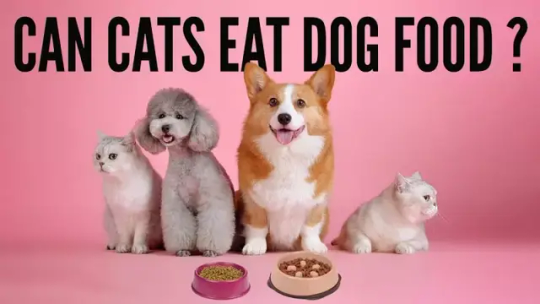
In conclusion
Does cat food taste good to dogs? Cats can eat dog food sometimes, but not as often as they should. It should not be their main source of food.
Can cats eat dog food?
Dog food might smell and taste like meat, or cats might be interested in it. Cats can eat dog food without getting sick right away, but it doesn't give them all the nutrients they need. Does cat food taste good to dogs? Eating small amounts of dog food once in a while might not have a big negative effect, but it also doesn't have any clear positive effects either.
Can cats get sick from dog food?
Cats can eat dog food without getting sick. But some dog foods may have garlic or onion powder in them, which is bad for cats in large amounts. Does cat food taste good to dogs? Cats that eat too much dog food can develop nutritional imbalances and deficiencies that can affect their health in the long term.
Why cat food is good for dogs
A lot of dog food has fats, proteins, and vitamins like D and B-complex. But these aren't made to meet the specific nutritional needs of cats. Does cat food taste good to dogs? For instance, the levels of protein are usually lower than what a cat needs to stay healthy.
How Much Cat Food Can They Eat?
A cat can eat a small amount of dog food for one or two meals if it has to, but it shouldn't be fed only dog food. Some fats and amino acids can be found in moderate amounts, but taurine, an important amino acid for cats, is missing. Does cat food taste good to dogs? If your dog eats too much dog food, it could be missing out on important nutrients and become sick from ingredients like garlic.
How to Give Cats Dog Food?
Only use dog food as a last resort and only in an emergency.
For better digestion, give your dog wet food instead of dry food.
Just a little bit at a time, and as soon as possible, switch back to cat food.
Does cat food taste good to dogs? If your cat won't eat dog food, it's time to switch them back to their normal food. Just put a little bit in your cat's usual dish to make it.
Other Options and Supplements
Extra taurine: Because dog food doesn't have enough taurine.
Arachidonic acid supplements are important for cats but not in dog food.
Omega-3 fatty acids can be found in fish oil.
Vitamin A supplements are important for your eyesight and immune system.
High-protein treats for cats: To give your cat the extra protein that dog food doesn't have.
Brands of cat food that we recommend:
The Hill's Science Diet
Blue Buffalo
Royal Canin
In conclusion, dog food is not good for cats, even though it is not immediately harmful. Does cat food taste good to dogs? It is very important to switch your cat back to a balanced cat food diet as soon as possible if they eat dog food sometimes or in an emergency. Before making big changes to your pet's diet, you should always talk to your vet first.
0 notes
Text
Get Nitra Whey Protein to Optimise Workouts Gains & Recovery
Nitra Whey Protein is suggested for those who need to fill the gap of testosterone deficiency, energy and performance. Nitra Whey Protein is European origin whey which contains protein, creatine, taurine, and rosehip extracts. Supplement is trending in India among the athletes and bodybuilders. Buy now

0 notes